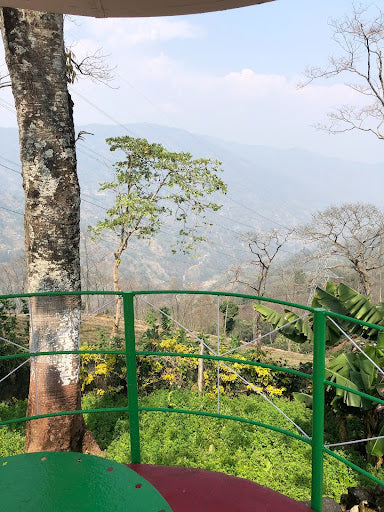Day 3: Chamong Lingia & Mariabong Gardens


The Lingia tea estate sits directly alongside and is the sister estate to Tumsong. It is run by a very experienced General Manager, Mr Shanka Choubhary. Lingia was the first garden to be planted by Andrew and Ernest Wernicke in 1867. It sits on a similar gradient and has the same enormous discrepancy in altitude from top to bottom of almost 1000m.

But fractional differences in the aspect of the estate, the make-up of the soil and emphasis in processing of the tea lead to a marked difference in the brew. Lingia teas have a distinct malty or oaty note that make for an especially interesting tea. I am less keen on this note coming through on the first flushes as it disturbs the light, fruity and clean purity of the first flush teas, but on the second flush it is extraordinary. We used to use a delicately smokey Yunnan tea for our Smoke House that had a bold malty undertone that made it perfect for weekend fireside drinking. This is much more delicate and refined but really distinctive nonetheless. The Lingia factory is well maintained and again impeccably clean and tidy.
The first stage of processing is withering. The tea is laid out on long narrow withering tables 80 ft long and 4ft wide. One table can take 120kg of tea at a time which then needs to wither for 14-16 hours to get the right level of wilt into the leaf. Too short and the leaf will crack in rolling, too much and the delicate top notes will get lost.

The leaf is gently heated from below by air ducted from large fans. Heat used to be supplied by coal, but 10 years ago, heating has shifted across to LPG due to growing pollution levels being detected in the soils. Alternative fuels are being introduced in some estates.


Once the leaf is soft and pliable, it is rolled to break the fibres to encourage the oxidation process. This is done in batches on large rolling machines. A batch is around 90 kg for 2nd flush, and maybe only 30-40kg for first flush. The tea is dropped from the floor above through chutes in the floor directly into the hopper of the machine. For first flush the machine gyrates for around 30 minutes and steadily rolls the leaf into lightly twisted strands. For second flush, a much more oxidised tea, the process is done in 2 stages, each of around 45 minutes.


Following rolling, the leaf is oxidised. The leaf is laid out on large tables and kept at constant temperature and humidity for a further 15 minutes or so for first flush and up to 3-4 hours for second flush depending upon the level of oxidation required. If the air is dry, extra humidity will be added by misting. In Lingia, they use an ingenious rotary mister that creates and distributes micro droplets. In other factories, this might be through misting heads installed in the ceiling.

The tea is then baked to dry and fix the flavour. The leaf is loaded onto a conveyor that runs back and forth through the oven for 20-25 minutes, until it reaches 2-3% humidity.

Sorting is carried out on vibrating tables that contain mesh trays. The larger leaf remains on the upper mesh and smaller pieces gradually drop through the trays until only dust is coming out at the bottom.



Still at this point, the tea has been kept separate by pick: tea that comes from a particular zone within the garden. Each zone will vary by altitude, aspect, soil type and pH and also the specific variety. Only once the tea has been tasted are these individual picks blended to create the particular invoice. The estate will be able to blend to create estate character tea, or of the styles demanded by particular customers.

There is a rich tradition of bungalow life in Darjeeling. The bungalows were built by the original tea planters to house their families, but also to entertain and, alongside the Planters Club, became the heart of social life across Darjeeling. And they serve much the same purpose today, housing the Estate Manager and their family and welcoming buyers from around the world. Many have also been redeveloped as homestays for tourism.
The Lingia bungalow is magical. Sitting high atop the estate, views out are incredible across the valley. It was built in 1869 by Ernest Wernicke and before the building of the Tumsong estate, housed Ernest and his wife, and his brother Andrew and his young family.
Following the tradition of garden planting, but taking it to a new level, the flower displays around the house are stunning. I just want to spend a long lazy afternoon in that armchair in the window.








